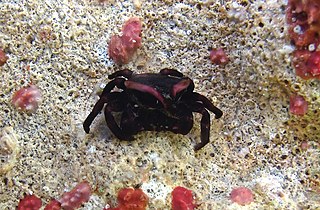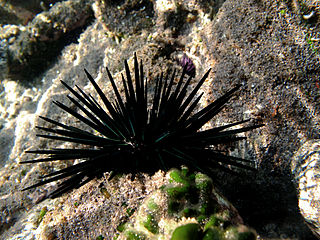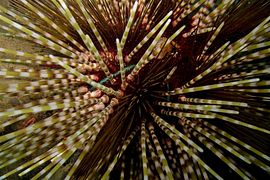
Sea urchins are spiny, globular echinoderms in the class Echinoidea. About 950 species of sea urchin are distributed on the seabeds of every ocean and inhabit every depth zone from the intertidal seashore down to 5,000 meters. The spherical, hard shells (tests) of sea urchins are round and covered in spines. Most urchin spines range in length from 3 to 10 cm, with outliers such as the black sea urchin possessing spines as long as 30 cm (12 in). Sea urchins move slowly, crawling with tube feet, and also propel themselves with their spines. Although algae are the primary diet, sea urchins also eat slow-moving (sessile) animals. Predators that eat sea urchins include a wide variety of fish, starfish, crabs, marine mammals, and humans.

The Diadematidae are a family of sea urchins. Their tests are either rigid or flexible and their spines are long and hollow.

The diadema urchin or blue-black urchin is a species of tropical sea urchin, member of the Diadematidae family.

Echinothrix is a genus of sea urchins which was first described in 1853 by Wilhelm Peters, a German naturalist and explorer.

Diadema antillarum, also known as the lime urchin, black sea urchin, or the long-spined sea urchin, is a species of sea urchin in the family Diadematidae.

Diadema setosum is a species of long-spined sea urchin belonging to the family Diadematidae. It is a typical sea urchin, with extremely long, hollow spines that are mildly venomous. D. setosum differs from other Diadema with five, characteristic white dots that can be found on its body. The species can be found throughout the Indo-Pacific region, from Australia and Africa to Japan and the Red Sea. Despite being capable of causing painful stings when stepped upon, the urchin is only slightly venomous and does not pose a serious threat to humans.

Astropyga radiata, the red urchin, fire urchin, false fire urchin or blue-spotted urchin, is a species of sea urchin in the family Diadematidae. It is a large species with long spines and is found in the tropical Indo-Pacific region. It was first described in 1778 by the German naturalist Nathaniel Gottfried Leske.

Heterocentrotus mamillatus, commonly known as the slate pencil urchin, red slate pencil urchin, or red pencil urchin, is a species of tropical sea urchin from the Indo-Pacific region.

Arbacia lixula, the black sea urchin, is a species of sea urchin from Europe.

Tripneustes gratilla, the collector urchin, is a species of sea urchin. Collector urchins are found at depths of 2 to 30 metres in the waters of the Indo-Pacific, Hawaii, the Red Sea, and The Bahamas. They can reach 10 to 15 centimetres in size.

Echinoecus is a genus of crabs that live in association with sea urchins. Formerly considered monotypic, the genus is now thought to contain three species:

Asthenosoma varium is a sea urchin. Growing up to 25 cm (10 in) in diameter, it lives on sand and rubble sea bottoms in the Indo-Pacific, from the Red Sea to Australia and Southern Japan. Its venom tipped spines, with distinctive globular swellings below the tip, can inflict a painful sting if handled; the pain lasts as long as several hours. This capacity, perhaps coupled with its reddish-brown colour, has given it the common name fire urchin; other commonly used names are Pacific fire urchin, elusive sea urchin, variable fire urchin, and electric sea urchin.

Heterocentrotus is a genus of slate pencil urchins, part of the familia Echinometridae. They are mainly found in the Indo-Pacific basin, especially in Reunion or Hawaii. This genus appeared in the Miocene and spread throughout the warm Indo-Pacific.

Centrostephanus longispinus, the hatpin urchin, is a species of sea urchin in the family Diadematidae. There are two subspecies, Centrostephanus l. longispinus, found in the eastern Atlantic and Mediterranean Sea and Centrostephanus l. rubricingulus, found in the western Atlantic.

Diadema paucispinum, the long-spined sea urchin, is a species of sea urchin in the family Diadematidae. It is found in the western Indo-Pacific Ocean and in Hawaii and other east Pacific islands.

The black margate, also known as black bream, black thicklip, dogfish, lippe, Mexican bull, pompon, Spanish grunt, surf bream, sweetlips or thicklip grunt, is a species of marine ray-finned fish, a grunt belonging to the family Haemulidae. It is native to the western Atlantic Ocean.

Diadema savignyi is a species of long-spined sea urchin belonging to the family Diadematidae. Common names include long-spined sea urchin, black longspine urchin and the banded diadem. It is native to the east coast of Africa, the Red Sea, the Indian Ocean and western Pacific Ocean. It was first described in 1829 by the French naturalist Jean Victoire Audouin. The specific epithet honours the French zoologist Marie Jules César Savigny who described many new marine species from the Mediterranean Sea and Red Sea. The type locality is Mauritius.
Paracorynactis is a genus of corallimorphs from the western Indo-West Pacific. They are specialized predators of echinoderms, and are notable for preying on the destructive crown-of-thorns starfish among others. The genus is monotypic with the single species, Paracorynactis hoplites.

Stomopneustes variolaris, the black sea urchin or long-spined sea urchin, is a species of sea urchin, the only one in its genus Stomopneustes and only species still alive in its family Stomopneustidae. It is found throughout the tropical Indo-Pacific, with a patchy distribution.

























